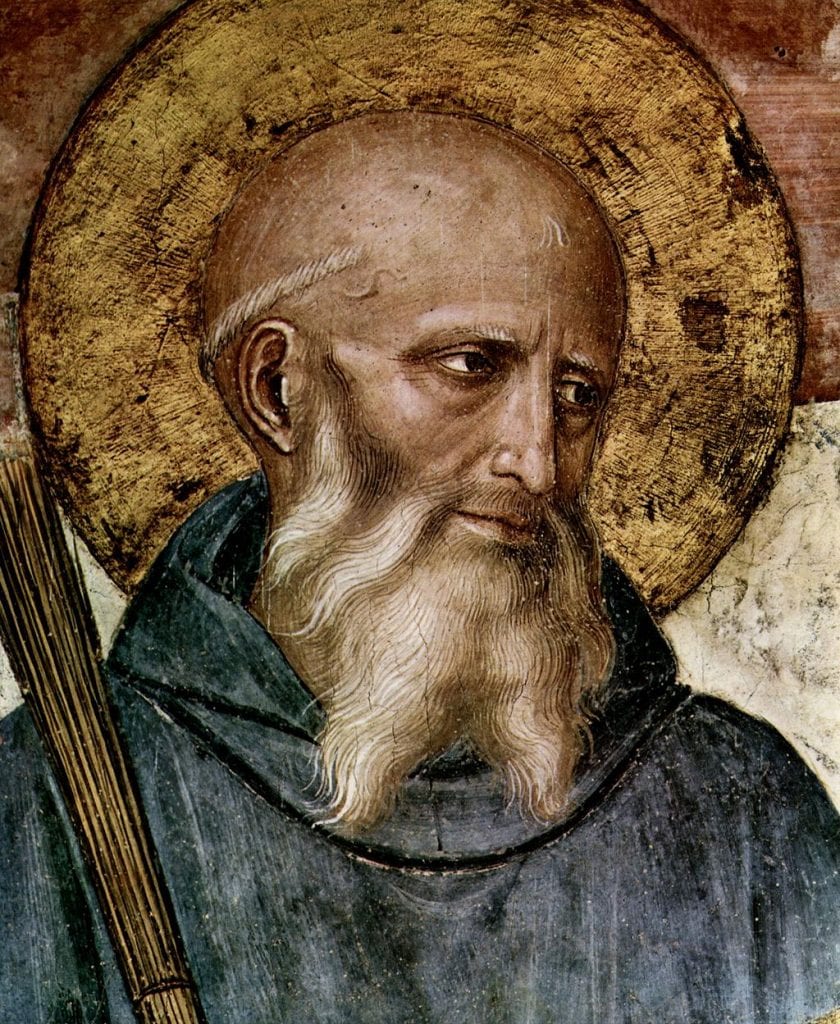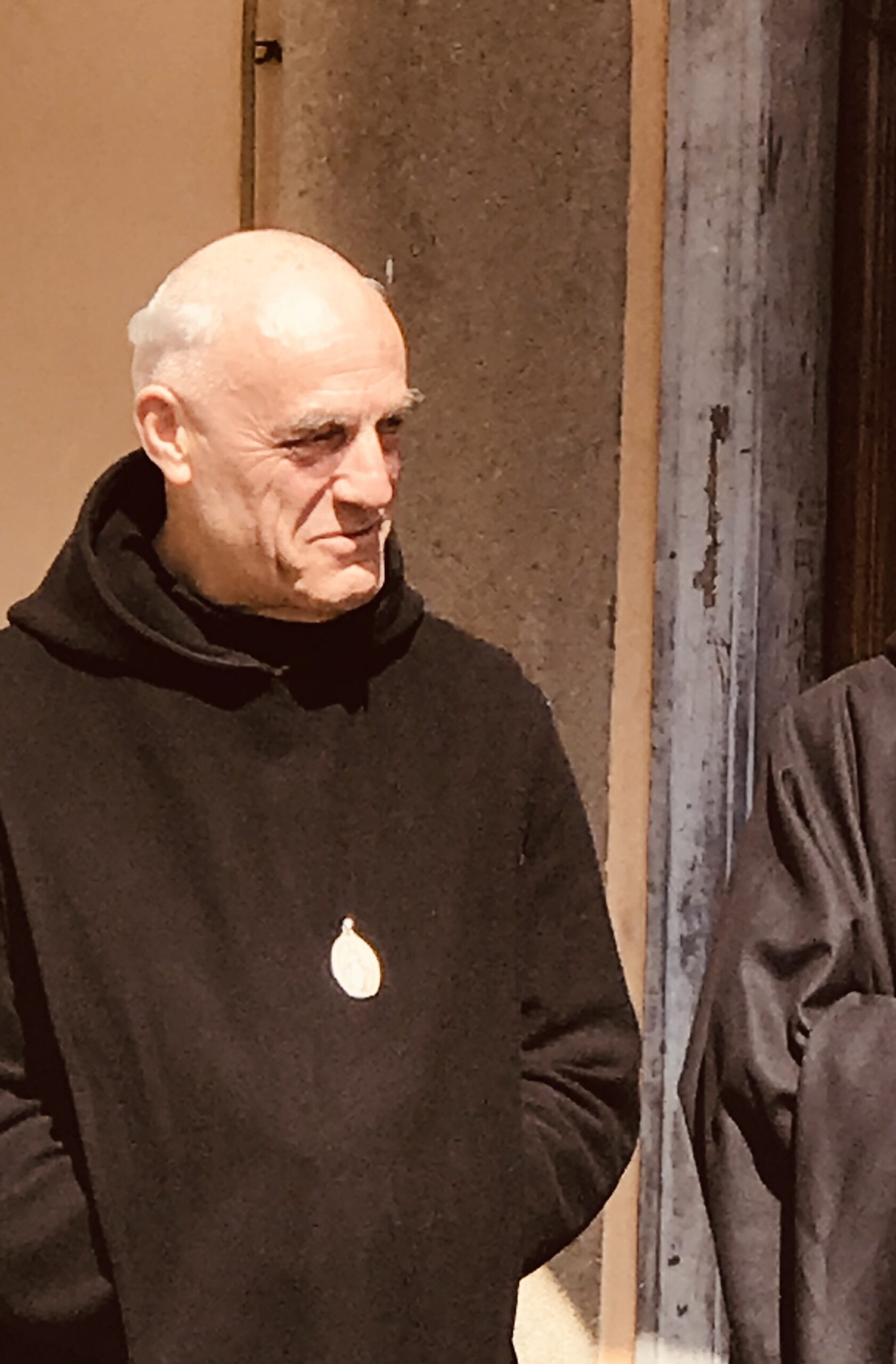In His perfect and loving Providence, God has, throughout the history of the Church, raised up souls specially called by Him to witness to His unchanging Truth in response to the ever-changing needs and circumstances of the times. These are the saints; men and women who swim heroically against the current of the world, fighting its errors and by their very life shining like beacons in the darkness, so that all may find refuge in their light.
St. Benedict was certainly one such soul, called by God to lead countless others to the heights of sanctity by virtue of his Holy Rule, notable both for its prudence and profound supernatural spirit. The sons and daughters of St. Benedict would go on to accomplish many things, most notably the preservation and enrichment of European culture during the turbulent and difficult first centuries of the Middle Ages.
This fruitfulness, which comes surely from the overabundant treasure of God’s love, should not, however, deter the mind from seeing clearly that the first and most important purpose of the monastic life is the pursuit of God alone, apart from all other ends, as good and worthy as they may be (“Nihil Operi Dei praeponatur” – chapter 43, The Holy Rule). The secret of Our Founder’s work is to be truly understood and appreciated in seeing the monk as one who stands as a constant reminder of the existence of God.
Throughout the centuries, many Benedictine monks and nuns have fought to preserve this original intention and spirit of St. Benedict, striving to avoid the pitfalls and abuses that threatened to weaken or destroy the monastic charism and introduce a worldly spirit into the monasteries.
We come then to a notable son of St. Benedict, born in the early 1800s in France, in the aftermath of the brutal and impious French Revolution, which heralded a time of darkness for the faithful of the country and would bring forth many pestilential fruits in the heart of Christendom. We are speaking of Fr. Jean-Baptiste Muard, who would be inspired by God to light a candle in such darkness by founding a community of Benedictine monks dedicated to a life “humble, poor and mortified” according to the primitive purity of the Holy Rule and consecrated to the Sacred Heart of Jesus and the Immaculate Heart of Mary.
His intention was to make reparations for the sins of his time and to reignite the flame of the Faith in the hearts of his wayward contemporaries. That is how the Abbey of “La Pierre-Qui-Vire” was founded on the 2nd of July 1850.
It was a small community at first, consisting of only three monks, but their fervor and dedication soon turned it into a flourishing monastery. After the premature death of Fr. Muard in 1854, the Lord raised up another soul with the mission of continuing and expanding his work, Dom Romain Banquet, who came to La Pierre-Qui-Vire not ten years after the death of its founder.
Because of his special talent for spiritual direction, he was made master of novices and formed many monks in the spirit of Fr. Muard, focusing especially on the interior life, which he regarded as the heart of the monastic vocation. Romain Banquet would then meet the seventeen-year-old Marie Cronier, a young woman favored by extraordinary graces.
Our Lord revealed to Miss Cronier that he desired the continuation of Fr. Muard’s work. God spoke to her of His desire for interior souls, entirely devoted to living in union with Him; these would be generous souls given to contemplation, great and noble in virtue, who would rediscover the primitive religious virtues of the first disciples of St. Benedict and whose sole thirst would be for sanctity. In Mother Marie Cronier’s own words, Jesus “wants the Holy Rule of St. Benedict studied, loved and translated into action to find holiness”. It seemed that in a time of social and spiritual upheaval, Jesus desired to rebuild the strongholds of monastic life, which had already once been called to be the bastions of civilization in a time of great transformation.
Because of his special talent for spiritual direction, he was made master of novices and formed many monks in the spirit of Fr. Muard, focusing especially on the interior life, which he regarded as the heart of the monastic vocation. Romain Banquet would then meet the seventeen-year-old Marie Cronier, a young woman favored by extraordinary graces.
Our Lord revealed to Miss Cronier that he desired the continuation of Fr. Muard’s work. God spoke to her of His desire for interior souls, entirely devoted to living in union with Him; these would be generous souls given to contemplation, great and noble in virtue, who would rediscover the primitive religious virtues of the first disciples of St. Benedict and whose sole thirst would be for sanctity. In Mother Marie Cronier’s own words, Jesus “wants the Holy Rule of St. Benedict studied, loved and translated into action to find holiness”. It seemed that in a time of social and spiritual upheaval, Jesus desired to rebuild the strongholds of monastic life, which had already once been called to be the bastions of civilization in a time of great transformation.
It was under these inspirations that Roman Banquet and Miss Marie Cronier founded the twin monasteries of St. Benedict and St. Scholastica in 1890, but half a mile apart at En-Calcat, on a property near Dourgne belonging to Romain Banquet’s family. It is an ancient custom of the Benedictine order to found twin community of nuns and monks close to each other, a tradition started by St. Benedict himself with his sister St. Scholastica. Roman Banquet and Marie Cronier became abbot and abbess of their respective monasteries and strove to form the interior souls that Our Lord had asked for. Mother Marie Cronier trained her daughters in the ideal of purity of mind and body, so that they would be “an enclosed garden, a community of interior souls that rejuvenate fervor and remind us of the virgins of the first centuries of the Church”.
The efforts of Dom Romain Banquet and Mother Marie Cronier were blessed by God, so that from the first foundation blossomed several others, including a monastery at Tournay. This is where the young Gerard Calvet made his vows and became a Benedictine monk in 1951. He was ordained a Catholic priest and in 1963 was sent to help with a foundation of his monastery in Brazil. Upon returning to France in 1968 he found the religious life of the abbey completely transformed in the wake of the reforms of Vatican II. Feeling unable to live with those changes, he asked for permission to be exclaustrated and spend some time first with the Carthusians and then living as a hermit. It was only at the request of a few young men desirous of living the traditional monastic life that he formed the intention of founding his own monastic community, which would become the abbey of Sainte-Madeleine du Barroux in 1970. Again, God raised up a new monastic foundation to respond to the confusion and uncertainty of the times.
We come then to the first of the sons of Dom Gerard, Fr. Jehan de Belleville, who desired to continue the work of his spiritual father. Providence would lead him to Italy, where he founded the monastery of St. Catherine of Siena in 2008 in the diocese of Albenga-Imperia. He decided to consecrate the community to the Immaculate Heart of Mary, following in the footsteps of Fr. Muard, who said that “the virtues that must constitute the essential component of our society are the virtues par excellence of the Heart of Jesus and of His Holy Mother”. The monks thus became the Benedictines of the Immaculate.
In 2021 Fr. Jehan helped found a feminine branch of the Benedictines of the Immaculate in the hills of Villatalla. This community has a strong spiritual link with our brother monks, as our founders desired and counseled: “may Jesus guide us and permit us to develop a double Work for Him, according to His Heart. It is important to make the union of the two families very solid in the future…” (Dom Romain Banquet, November 1891); “what Jesus wants is one Work, brothers and sisters. We must not separate this, for we would immediately be on the wrong track.” (Mother Marie Cronier, February 1890).
Our community of Benedictine sisters endeavors to observe the spirit and traditions outlined in this brief history, so as to continue the work of our founders and thus give glory to God according to our specific charism.



